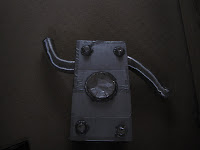So-today was the day! After weeks of preparation this morning we trekked through the snow to Browick Road Infant School and went straight into our Theatre in Education (from now on I will call it TIE) performances. Unfortunately several important members of our group weren't there so some very brave people kindly stepped in and improvised for us. I was dressed as a teddy bear, Jacob was a robot and Laura took Freya's place as a Barbie doll. However, the Red Cross charity group went first with Elliot, Ellie, Holly and Ryan at the last minute instead of Bradley. They portrayed a quiz show, with Elliot as the host, asking Ryan questions about how often he donates to charity and how the donations help others worldwide in war-torn countries. Next we watched a 'clip' of the Red Cross helping a young person who had lost a close friend. They tried to show how one minute he had just been an ordinary boy playing with his friends and then suddenly he had been shot. They interacted well with the audience but obviously it wasn't as good as it could have been because of the absence of some students.
 Then it was my group with me, Jacob, Sam and Laura stepping in. It went surprisingly well; we said all our lines and Laura did really well making up lines that would fit with our idea of some lonely toys who wanted to be played with or at least donated to someone who wanted them. At the end Sam asked the audience some questions about what charity shops were and if anyone donated-we got a good response from the Year 2's.
Then it was my group with me, Jacob, Sam and Laura stepping in. It went surprisingly well; we said all our lines and Laura did really well making up lines that would fit with our idea of some lonely toys who wanted to be played with or at least donated to someone who wanted them. At the end Sam asked the audience some questions about what charity shops were and if anyone donated-we got a good response from the Year 2's. Jacob's robot costume
Next the Browick students went back to their classrooms and we got into our workshop groups. Again we were missing some members and in the end it was just me, Laura, Ross and Jacob in our group. Disaster struck again when we realised Chloe had our updated workshop plan so we had to do just what we could remember. We started by playing the traffic light game (red means stop, amber means sit down and green is go) and some other games to warm them up. Jacob 'hid' some giant foam jigsaw pieces and told the Year 2's to find them. but explained that if they found more than one they had to give the other to someone else who didn't have one-this was to try and get them to share. After this Ross and I acted a scene where Ross is playing with a toy and I snatch it from him; we were showing them how NOT to share and asked a little girl to show us what we should do. Then they got into pairs and asked them to share either a toy or a book and they were really good-they even managed to both play with it nicely together. We played a game of sleeping lions to finish off and calm them down and Laura asked them a few questions so we could see whether they had understood and whether it had been a success. Altogether I think it went well but it would have been even better if we had everyone so we could do everything we were supposed to and if we had our workshop plan it would have seemed more professional.

 Browick Rd
Browick Rd









